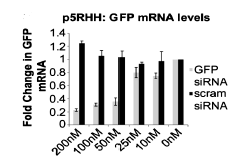Competitive Advantages
- Improved ability to transfect desired cells
- Improved molecular targeting
- Improved efficacy
- Numerous applications in research and medicine
Summary
Researchers at USF have discovered a method to transfect cells more effectively using the peptide melittin. Melittin is an amphipathic peptide, allowing it to enter and disrupt a cell membrane. When combined with siRNA at a specific volume, the siRNA is condensed into a nanoparticle. This is then combined with a hyaluronic acid (HA) to make a small, very transfective particle that resists endosomal destruction. This method allows for improved molecular targeting and efficacy, and has wide applications in research and medicine.

A Comparison Between the mRNA Levels of the Negative Control (Scramble siRNA) and the Protein siRNA
Desired Partnerships
- License
- Sponsored Research
- Co-Development